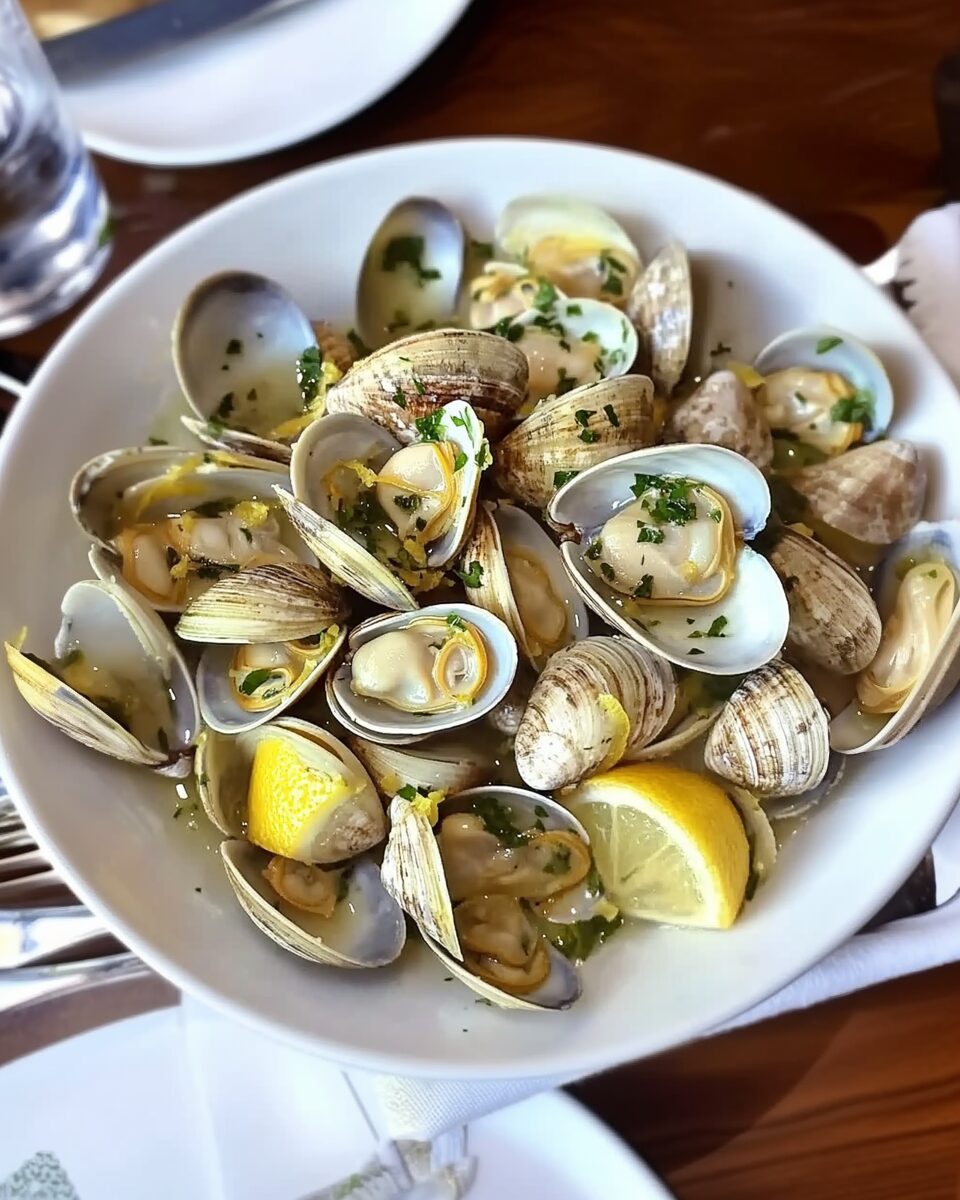Lemon Garlic Steamed Clams, known in Portuguese as Amêijoas à Bulhão Pato, is a classic seafood dish celebrated for its simplicity and vibrant flavors. This traditional recipe combines tender clams with the aromatic essence of garlic, fresh coriander, and a zesty touch of lemon juice, making it a favorite appetizer in Portuguese cuisine.
Full Recipe:
Ingredients
-
1 kg (2 1/4 pounds) fresh clams
-
100 ml (1/2 cup) olive oil
-
4 cloves of garlic, minced (or 1 teaspoon garlic powder)
-
Fresh coriander or parsley, chopped (to taste)
-
Juice of one lemon
-
1 teaspoon salt
-
1/2 teaspoon pepper
Directions
1. Prepare the Clams:
Soak the clams in fresh water seasoned with salt for about 1 to 2 hours to remove any sand. After soaking, wash them thoroughly under running water.
2. Sauté the Garlic:
In a large skillet, heat the olive oil over low heat. Add the minced garlic and sauté for about 2 to 3 minutes, stirring occasionally to prevent burning.
3. Cook the Clams:
Add the cleaned clams to the skillet, stirring to coat them with the garlic-infused oil. Cover the skillet and cook over medium-low heat for approximately 7 to 10 minutes, or until all the clams have opened. Occasionally shake the skillet during cooking to ensure even heat distribution. Discard any clams that do not open.
4. Season and Serve:
Once the clams have opened, turn off the heat. Season with pepper, drizzle with fresh lemon juice, and sprinkle with chopped coriander or parsley. Serve immediately with crusty bread to soak up the flavorful broth.
Nutrients
Per Serving (serves 4):
-
Calories: 327 kcal
-
Total Fat: 24 g (37% DV)
-
Saturated Fat: 3.5 g (17% DV)
-
Cholesterol: 0 mg (0% DV)
-
Sodium: 944 mg (39% DV)
-
Total Carbohydrate: 28.5 g (9% DV)
-
Protein: 1.5 g
Historical Origins
The history of Amêijoas à Bulhão Pato is closely tied to Lisbon, Portugal’s capital city. The dish gained popularity in the 19th century and has remained a staple of Portuguese dining ever since. It was named after Raimundo António de Bulhão Pato, a notable poet, diplomat, and gastronome who lived during this period. While he may not have invented the dish himself, his passion for gastronomy and his influence in cultural circles led to the naming of this seafood delicacy in his honor.
During the 1800s, Lisbon was a bustling hub of trade and culture, and seafood featured heavily in its local diet. Clams were abundant and inexpensive, making them a popular choice for both home cooks and professional chefs. The minimalist approach to preparing clams—with olive oil, garlic, cilantro, and lemon juice—was a reflection of the Portuguese culinary philosophy: to use high-quality ingredients, treat them with respect, and let their natural flavors shine.
Over time, the dish’s popularity spread beyond Lisbon to coastal towns and even across the Portuguese diaspora. Today, Amêijoas à Bulhão Pato is served in restaurants and homes throughout Portugal and around the world, beloved for its clean flavors and quick preparation.
Cultural Significance
In Portuguese culture, food is a form of connection and community, and Amêijoas à Bulhão Pato embodies this spirit perfectly. It’s a dish often associated with summer gatherings, seaside vacations, and relaxed afternoons spent in the company of good friends. The act of sharing a bowl of clams, dipping bread into the fragrant broth, and savoring the interplay of garlic, herbs, and citrus creates a convivial dining experience that is as much about human connection as it is about flavor.
This dish also highlights the importance of seafood in the Portuguese diet. With over 800 kilometers of Atlantic coastline, Portugal has long relied on the ocean for sustenance, and seafood plays a central role in the national cuisine. Clams, along with other shellfish like mussels, cockles, and shrimp, are common in Portuguese markets and feature in a variety of traditional recipes.
Amêijoas à Bulhão Pato is a showcase of what Portuguese cooking does best—using just a few ingredients to create something deeply satisfying. The simplicity of the dish makes it accessible, while its flavor profile appeals to even the most discerning palates. Whether served as a starter or part of a larger seafood feast, it holds a special place in the hearts of those who grew up with it and those discovering it for the first time.
Ingredient Philosophy
Although this article does not include the ingredient list or preparation steps, it’s worth discussing the philosophy behind the key ingredients. Portuguese cuisine places a premium on freshness and quality, especially when it comes to seafood. Clams must be fresh, properly cleaned, and preferably harvested from clean coastal waters. Their natural sweetness and slight brininess are what give the dish its core character.
Olive oil is another cornerstone of the dish, and Portuguese olive oil is particularly prized for its fruity, peppery notes. Used generously, it forms the base of the flavorful sauce that clings to each clam and begs to be mopped up with bread.
Garlic, lemon juice, and fresh cilantro (or occasionally parsley) are added to build a fragrant, zesty broth that balances richness and brightness. These ingredients are used in just the right proportions—not to overwhelm the clams, but to elevate them.
Regional Interpretations
While the traditional Lisbon-style Amêijoas à Bulhão Pato is the most recognized version, there are regional variations that reflect local preferences and ingredients. In the Algarve, for example, some cooks add a splash of white wine or dry sherry to the pan, creating a more complex and slightly boozier sauce. In coastal villages, you might find the dish prepared with razor clams or cockles instead of the more common carpet-shell clams.
Pairings and Serving Ideas
Amêijoas à Bulhão Pato is typically served as an appetizer, but it can easily be part of a larger meal, especially when accompanied by other seafood dishes. In Portugal, it’s common to begin a seafood meal with clams or shrimp, followed by grilled fish or a hearty seafood rice.
Crusty bread is essential for enjoying this dish properly. Portuguese broa (cornbread) or pão alentejano (rustic wheat bread) are ideal choices, offering both texture and flavor to absorb the broth.
Health and Nutrition
Beyond its delicious flavor and cultural relevance, Amêijoas à Bulhão Pato is a relatively healthy dish. Clams are nutrient-dense and low in calories, providing an excellent source of protein, vitamin B12, iron, and omega-3 fatty acids. These nutrients support heart health, red blood cell formation, and brain function.
Olive oil, another key component, is rich in monounsaturated fats and antioxidants, contributing to reduced inflammation and improved cardiovascular health. Garlic offers its own health benefits, including antimicrobial properties and potential cardiovascular support.
Popularity in Modern Cuisine
In recent years, traditional Portuguese dishes like Amêijoas à Bulhão Pato have enjoyed a resurgence, thanks in part to the global popularity of Mediterranean diets and the rise of culinary tourism in Portugal. Food lovers from around the world are discovering the depth and diversity of Portuguese cooking, and clams à la Bulhão Pato are frequently highlighted in travel shows, food blogs, and restaurant menus.
Chefs are also finding new ways to present this dish, elevating it with modern plating techniques or serving it with gourmet touches like infused oils or artisanal bread. However, the core remains unchanged: fresh clams, garlic, olive oil, herbs, and lemon—simple ingredients, expertly combined.
Conclusion
Amêijoas à Bulhão Pato is more than just a seafood recipe—it is a reflection of Portuguese history, culture, and culinary philosophy. From its poetic namesake to its modern-day popularity, it has remained a consistent favorite thanks to its approachable preparation and unforgettable flavor.






